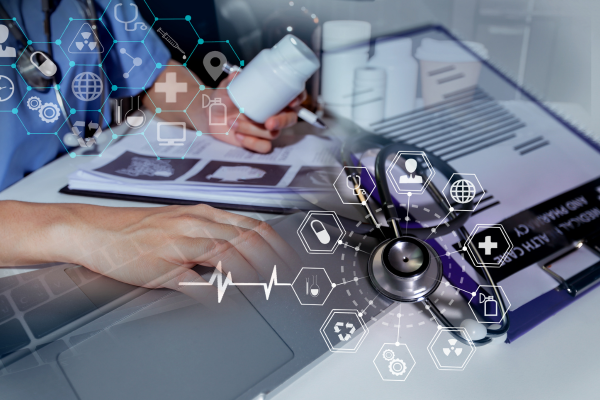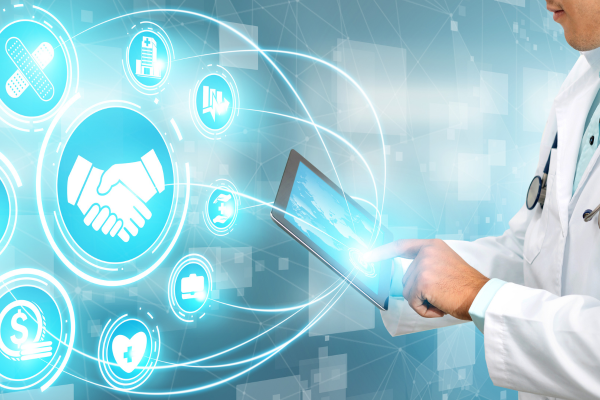
-
Apexlink
Real Estate
-
DLS
General Insurance
-
DMV
Government
-
Entiger
Fintech
-
GIS Mapping
Gas & Petroleum
-
HMS
Employee Benefit
-
HAWA
Government
-
Harley
Community
-
IHG
Hotel & Tourism
-
Sparkseeker
Humane Tech
-
Track Ninja
Sports
-
Response Vision
Disaster Management
- Artificial Intelligence
- Application Services
- Automation Services
- Cyber Security
- Chatbot Experts
- Data Analysis
- Data Warehouse Services
- Digital Commerce Services
- Digital Transformation
- Infrastructure Service
- IT Support
- IT Consulting
- IT Outsourcing
- IOS Development
- Android Development
-
Cross Platform Development
-
Gaming App Development
When you strip away the noise and look at the essence of technology's impact on our lives, you see that IoT technology stands out—not merely as a new tool but as the harbinger of a transformative era in healthcare. IoT is to healthcare what the PC was to office work or what the internet was to communication. The intervention of IoT in healthcare is a fundamental shift.
You used to call a doctor's office, wait on hold, exchange information slowly through intermediaries. It was a process that evolved little from the age of the house call. But that's changing. Technology, especially the internet, has always been good at removing unnecessary steps. And now, with IoT solutions, this same elimination of friction is coming to healthcare. This isn't technology for its own sake; this is using it to make healthcare more direct, more efficient, more tailored—to make it better.
Internet of Things & Healthcare: Historical Evolution

Startups are often the ones that drive technological evolution, and healthcare is no exception. In the beginning, healthcare IT solutions were not about algorithms and machine learning—it was about the simple act of making paper records digital. It was a first step, but in retrospect, a comparatively trivial one.
As these healthcare IT services matured, their founders started to see new possibilities. They weren't content just to digitize the old processes; they wanted to improve them. So, when the technology was ready, they were ready to take advantage of it. And that was the beginning of utilization of IoT in healthcare.
The real turning point for healthcare IT companies was when they started to understand what could be done with data. Not just the data they'd been digitizing, but new types of data that had never been captured before. They began to see patients not just as sources of episodic data, like test results, but as streams of continuous data.
When you start getting data in real time, you can do things you could never do before. For chronic conditions, which require constant management, or for postoperative care, the difference is night and day. With IoT, healthcare startups could ensure that a patient's care was informed by a continuous feed of data, allowing for preemptive medical decisions and drastically better outcomes.
So, it's no surprise that this was the direction healthcare IT services took. The companies that survived were the ones that understood what the new technology made possible. And as always, the key was to understand the implications of the technology before it was completely obvious to everyone.
Remote Monitoring Using IoT Healthcare Devices

The essence of using IoT in healthcare is to make everything work together: the devices, the networks, and the software. This is tricky, because although integration sounds like a straightforward technical problem, it's actually more about understanding deeply what doctors and patients need.
Advances in technology, especially IoT and faster connectivity like 5G, are solving the simpler half of the problem. The more complex half is about the software - how do you take all this data from a variety of different devices and make it useful? That's the real challenge.
Remote monitoring is perhaps the most immediate application of IoT in healthcare that people get excited about. And for good reason. When you have wearable IoT healthcare devices that can track vitals and report back whether patients are taking their medication, you have something that can really change the quality of care. Especially for things like chronic diseases or elderly care where constant monitoring was once impractical or intrusive, it's a game-changer.
This isn't just about having data for the sake of data. It's about maintaining the continuity of care no matter where someone is. After surgery, for instance, the recovery period isn't a black box to doctors anymore, and they can check their patient's progress as and when they want.
Improved Patient Outcomes
Imagine a healthcare system that's not just reactive but predictive, not just generic but deeply personal. That's where healthcare IoT comes in.
IoT medical devices collect streams of data that are like the vital signs of the healthcare system itself. This continuous flow of information—heart rates, glucose levels, sleep patterns—is the pulse that healthcare providers monitor, forming a rich tapestry of data that speaks more accurately about a patient's health than the occasional and fragmented traditional checkups.
What's remarkable about IoT in healthcare is not just the collection of data, but its synthesis and application. As these devices talk to each other and to the larger health IT systems, they're building a full picture of a patient's health that's continually updated in real-time. This dynamic view of a patient's health transforms how we think about care. Thanks to this data, patients don't just get a treatment plan; they get their treatment plan.
And because all these devices and systems are interoperable, the whole is greater than the sum of its parts. Each piece of data that adds context, makes the diagnoses faster and finer.
As patients see their own health reflected in this mirror of data, they're more satisfied because they're seen and treated as individuals. This isn't just a step forward in healthcare; it's a leap towards a system where outcomes are consistently improved because healthcare is understood as an ecosystem of interconnected parts, all working together to predict and personalize the path to well-being.
Benefits of IoT in Healthcare
When you merge healthcare with IoT, something interesting happens: medicine scales. Suddenly, the long tail of healthcare – those remote and underserved areas – becomes reachable. IoT technology acts as a lever that the healthcare industry can press to move these large, previously immovable barriers of accessibility. But there's a subtler benefit, one that's not as immediately obvious: cost. Hospital stays are expensive, and not just in money. There's a psychological cost to being in a hospital, a cost in time, a cost in lost work. If you can minimize those, you've made healthcare not just cheaper, but better. IoT healthcare devices at home can monitor what once required a bed and a bank of machines. The savings here are profound – and they accrue at both ends, to both providers and patients.
Then there's the matter of engagement. It's well known that users like devices that are user-friendly – that much is tautological. But the effects when those devices are also what keep you healthy? That's where things get interesting. It turns out that when people can easily track their health, they tend to act more healthily. So, these new devices not only passively monitor but actively encourage healthier behavior.
Early intervention is another area where IoT in healthcare shines. Real-time monitoring can be like an early warning system for your body, spotting trouble before you're even aware of it. And in medicine, timing is often critical. The earlier an issue is detected, the easier it's generally to treat. This is one of those cases where better technology translates directly into saved lives.
In all of these, what's striking is the pattern. IoT in healthcare is taking things that were previously scarce — access to medical care, low-cost management of chronic disease, patient engagement, early intervention — and making them abundant. And whenever you see that kind of pattern, you're often looking at something that's a leap forward.
Challenges and Solutions
The integration of IoT in healthcare is like trying to combine the fluidity of the internet with the solidity of the medical profession. It's a powerful idea, but fraught with obstacles.
Consider data security. As the quantity of health-related data balloons — which it inevitably will, given the trajectory we're on — the potential for breaches grows in proportion. This is not merely a technical problem, but a human one. Patients' lives and privacy are at stake. The more valuable the data you accumulate, the harder it is to both protect and utilize it without altering its nature. Startups often underestimate the sheer ingenuity and persistence of hackers. Adequate cybersecurity isn't just a feature; it's the bedrock upon which the entire edifice of healthcare IoT must be built.
The integration issue is as much about the past as it is about the future. Existing healthcare systems are a hodgepodge of legacy software, each piece a patchwork solution to a problem of its time. Introducing IoT medical devices into this mix is akin to running new software on an old computer. It can be done, but it's delicate work that requires deep understanding of both the old and the new systems.
And then there's the problem of scale. In a small trial, an IoT solution might work flawlessly. But as anyone who has tried to scale up a web application knows, the system that works for 100 users behaves very differently with 100,000. Healthcare IoT doesn't just need to work; it needs to work at enormous scale and without failing because several lives could depend on it.
These problems are intimidating, but they are not insurmountable. This is a domain where a small group of smart, motivated people can make a big difference. And when they do, the rewards — both monetary and societal — could be immense.
Conclusion
Healthcare has historically been a field where innovation is not just about new features but about life-changing, and often lifesaving, improvements. Today, the integration of IoT in healthcare is a particularly striking example of this. It's not just improving systems—it's improving outcomes. It's doing what the best technologies do: not just solving the problems we have, but solving problems we didn't realize were avoidable. With its capacity for enhanced remote monitoring, IoT is not just a step forward; it's a leap towards a world where healthcare is more accessible, where patient outcomes are not just better but fundamentally different, and where the benefits ripple out to affect millions of lives globally. It's the kind of world-changing ambition that startups should aim for.
Have a revolutionizing idea for the healthcare industry but not sure where to get started? Talk to one of our IoT healthcare experts today.







 Artificial Intelligence
Artificial Intelligence
 Blockchain
Blockchain Cloud Computing
Cloud Computing Infrastructure
Services
Infrastructure
Services Metaverse
Metaverse QA
Automation
QA
Automation UI/UX
UI/UX








